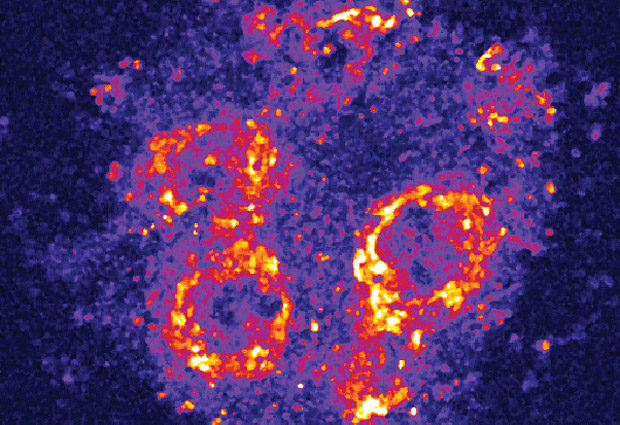
Read the latest Issue
What do cells in an embryo have in common with schools of fish, swarms of fireflies, and applauding audiences? A study by the Aulehla lab provides an intriguing answer.

When a mouse embryo is developing, the cells that will form its vertebrae periodically turn specific genes on and off, on and off, in a rhythmic manner. This is a remarkably coordinated process: rows of cells blink in succession, so that if you look at the whole embryo you see the blinking in waves.
VIDEO: Nature.
Each of these waves ends in the formation of a vertebra. But how does it start? “How do thousands of cells manage to turn genes on in such a coordinated fashion, in space and time?” Alexander Aulehla, a group leader at EMBL Heidelberg, wanted to know. Scientists in the field had pondered several possibilities. There could be an outside cue that sets the rhythm, or a ‘pacemaker’ cell – or group of cells – that tells the others when to blink. But instead, Aulehla’s postdoc Charisios Tsiairis found that the cells synchronise on their own: they self-organise, as the scientists say.
Studying how these waves start would be extremely difficult to do in an embryo, so the EMBL researchers devised a way to answer the question in a lab dish. In work published today in Cell, Tsiairis took tissue from several mouse embryos, separated it into individual cells, and then placed a random mix of cells – from different embryos and different parts of the embryo – together. “So we started from a situation which we call ‘chaotic’, and let the system unfold its potential,” Aulehla explains. At first, the cells blinked randomly, but they quickly started blinking in sync. Next, they formed circles where blinking happened in a wave, rolling outwards from the centre.
VIDEO: EMBL/C.Tsiairis
This showed that the cells don’t need any outside cues to determine when – and how fast – they blink. But were there specific cells that dictated the rhythm? “We found that the answer is no,” says Tsiairis. “It’s a true democracy: the cells all adjust their blinking rate to reach a compromise.”
Aulehla’s lab is now investigating if the principles they found in the dish apply in the embryo, when the first waves are set up. The group is also looking into how cells read the rhythm at which those around them are blinking.
The scientists are confident that similar mechanisms are at work in human embryos, as vertebrae are formed in a very similar way in all vertebrates. What’s more, says Aulehla, researchers working with insects have recently found indications of similar waves – albeit of different genes – in the flour beetle Tribolium castaneum. “That’s very exciting; it would be interesting to see how those are set up,” he says.
that’s where self-organisation is so powerful
In searching for such answers, Aulehla aims to keep self-organisation in mind. After all, he points out, when you’re investigating how a pattern arises in development, if you trace the chain of events back far enough, you’ll reach a point when something just has to have happened for the first time. “That’s where self-organisation is so powerful: all that’s required are elements with certain properties, which interact locally, and that’s it – that’s enough to bring about complex patterns. So once you know these properties, and importantly the interactions, then you understand how those complex structures can spontaneously appear. I find this fascinating!”
Evidence of this fascination can be found right on his desk, where a book titled Self-organisation in biological systems lies within easy reach. In it are accounts of how synchronised flashes arise in swarms of fireflies, how schooling fish form patterns, … it even examines the role of self-organisation in the building of termite nests. Aulehla’s own work could now add a new example: how genetic waves are formed in developing embryos. And at the end of his next talk, perhaps he will listen for the synchronised clapping that can emerge spontaneously from an audience.
Looking for past print editions of EMBLetc.? Browse our archive, going back 20 years.
EMBLetc. archive